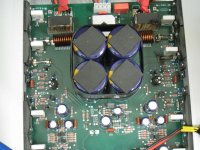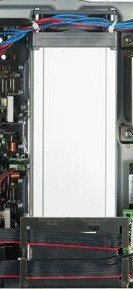Cradle22,
I just want to be positive I understand you right. You compared the End Milleniums and the P3A in a full range set up and you did not here any difference? That’s odd the two amps are very different.
I just want to be positive I understand you right. You compared the End Milleniums and the P3A in a full range set up and you did not here any difference? That’s odd the two amps are very different.
Careful now!
That is a very large can of worms you just opened up there. Two camps:
1) All amps have charicteristic "sound" and some are distinguishable from others.
2) All amps that are properly built will sound the same when operated in their linear region of operation
...confusing the matter are the studies done that prove both camps to be right, and some prove both right at the same time, depending on who is explaining the results...
How fast can a thread get hijacked? Maybe you will find out if you watch this space!
That is a very large can of worms you just opened up there. Two camps:
1) All amps have charicteristic "sound" and some are distinguishable from others.
2) All amps that are properly built will sound the same when operated in their linear region of operation
...confusing the matter are the studies done that prove both camps to be right, and some prove both right at the same time, depending on who is explaining the results...

How fast can a thread get hijacked? Maybe you will find out if you watch this space!
Yeah, Gryphon's are nice, minus the "e".
I heard the DM100 once long time ago, awesome amplifiers.
Another Danish Rasmussen, who knows, one day i may own a classic Rasmussen design.
I heard the DM100 once long time ago, awesome amplifiers.
Another Danish Rasmussen, who knows, one day i may own a classic Rasmussen design.

That is a very large can of worms you just opened up there. Two camps:
1) All amps have charicteristic "sound" and some are distinguishable from others.
2) All amps that are properly built will sound the same when operated in their linear region of operation
...confusing the matter are the studies done that prove both camps to be right, and some prove both right at the same time, depending on who is explaining the results...
How fast can a thread get hijacked? Maybe you will find out if you watch this space!
Hmm... I am need to studying something from this too.
One thing which has not been mentioned is that RET (and other similar technologies, for example see Sanyo 2SB817/2SD1047) have substantial emitter resistance 'built in' because of the many parallel transistor cells.
This is evident on the Vbe-Ic graphs in the datasheets, which show practically linear behavior once the Vbe=0.6V or so knee is reached. This means bias current setup is will vary compared to some established rules (see D. Self treatise on optimum bias). The 'internal emitter resistors' are sometimes sufficient even to operate the devices without external resistors while still maintaining temperature stability, if the thermal interface to the bias servo is done right. The approximate equivalent value of the internal resistance is usually on the order of what you would minimally use externally, about 0.1 ohms - however, depending on type, it may be different for the PNP and NPN counterparts, which means there will be transfer function asymetry around the crossover point in a complementary amp. True, there are many other mechanisms that cause many such asymetrical behaviors, inherent in the differences between P and N doped silicon but this is one that can actually be corrected by using asymetrical external emitter resistors.
This is evident on the Vbe-Ic graphs in the datasheets, which show practically linear behavior once the Vbe=0.6V or so knee is reached. This means bias current setup is will vary compared to some established rules (see D. Self treatise on optimum bias). The 'internal emitter resistors' are sometimes sufficient even to operate the devices without external resistors while still maintaining temperature stability, if the thermal interface to the bias servo is done right. The approximate equivalent value of the internal resistance is usually on the order of what you would minimally use externally, about 0.1 ohms - however, depending on type, it may be different for the PNP and NPN counterparts, which means there will be transfer function asymetry around the crossover point in a complementary amp. True, there are many other mechanisms that cause many such asymetrical behaviors, inherent in the differences between P and N doped silicon but this is one that can actually be corrected by using asymetrical external emitter resistors.
is there a way us poorly equipped amateurs can identify the internal Re asymmetry and from there calculate and/or measure the asymmetry in the external Re?RET (and other similar technologies, for example see Sanyo 2SB817/2SD1047) have substantial emitter resistance 'built in' because of the many parallel transistor cells..........................however, depending on type, it may be different for the PNP and NPN counterparts, which means............... this is one that can actually be corrected by using asymetrical external emitter resistors.
Can the correction thus applied be confirmed as correct or in need of more adjustment?
Do the mjl4281/mjl4302a rate favourably against these Sankens?
Simple answer is NO. Sanken produce the best high power transistors at the moment.
The Odyssey amps, both the Khartago and Stratos, use these transistors. Phenomenal sound, comparable to amps costing 100x more (yes, 100x more!).
Simple answer is NO. Sanken produce the best high power transistors at the moment.
Homemodder, have you done comparisons, measurements etc. I would expect subtle differences?
The Odyssey amps, both the Khartago and Stratos, use these transistors. Phenomenal sound, comparable to amps costing 100x more (yes, 100x more!).
Do they use Sankens or Onsemi?
Do they use Sankens or Onsemi?
Sankens. These are USA made "clones" of the Symphonic Line RG11, currently selling for Euro 3,500.
http://e-shop.highendstudios.de/AMP....html?XTCsid=0e1467734afa6c0c1b6a3b68612d06c5
...musical fidelity really liked these transistors, though I have no idea if they were used elsewhere...
Stuart
these are used in Cambridge Audio's A3i
Sanken 2SC2922/2SA1216 vs. best of ON Semi MJL4281/MJL4302.
Which are winner?! For sounding, not for tech spec.
Which are winner?! For sounding, not for tech spec.
A1215/C2921 > A1216/C2922 > A1295/C3264 > MJL4302/MJL4281
(for tech spec lovers : compare the 5Vce beta graph of the MJL with the one of the Sanken at 4Vce)
Each of the Marantz MM70** series has the Sanken MT200 devices, amusing that Marantz stepped up to silent-running blower cooling.
2-channel MM7025 =>
(for tech spec lovers : compare the 5Vce beta graph of the MJL with the one of the Sanken at 4Vce)
Each of the Marantz MM70** series has the Sanken MT200 devices, amusing that Marantz stepped up to silent-running blower cooling.
2-channel MM7025 =>
Attachments
I am always in a picture mood.
Here is one of the late 90s Pioneer M8 Japlifier, running on double-6 copper covered Sanken ring-emitters.
$15.000 is a bit much for a 90 watts in 8 Ohm, imo.
According to a German test at the time as good as my Aleph 0s, twice the money.
Mmmm. Pity about those cheap Phenolic PCB's.
- Status
- Not open for further replies.
- Home
- Amplifiers
- Solid State
- The skinny on Sanken 2SA1216 Epitaxials

